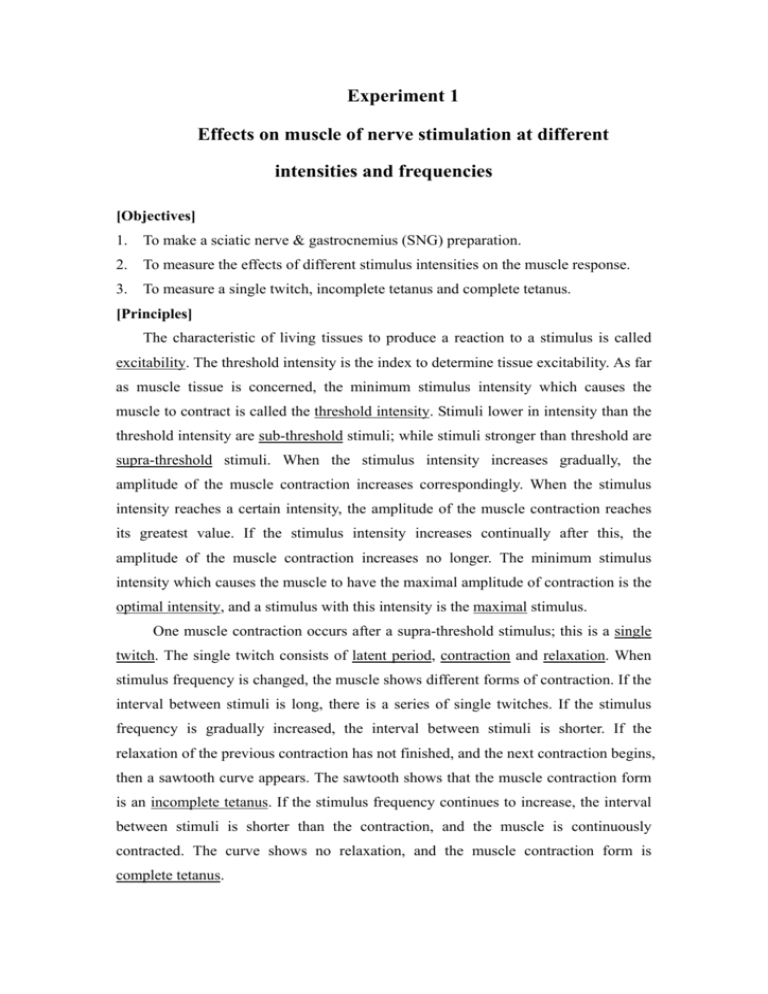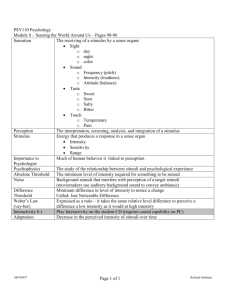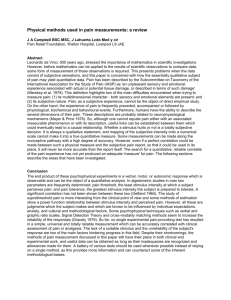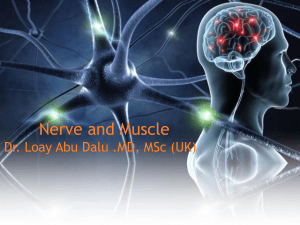Experiment 1 Effects on muscle of nerve stimulation at different
advertisement

Experiment 1 Effects on muscle of nerve stimulation at different intensities and frequencies [Objectives] 1. To make a sciatic nerve & gastrocnemius (SNG) preparation. 2. To measure the effects of different stimulus intensities on the muscle response. 3. To measure a single twitch, incomplete tetanus and complete tetanus. [Principles] The characteristic of living tissues to produce a reaction to a stimulus is called excitability. The threshold intensity is the index to determine tissue excitability. As far as muscle tissue is concerned, the minimum stimulus intensity which causes the muscle to contract is called the threshold intensity. Stimuli lower in intensity than the threshold intensity are sub-threshold stimuli; while stimuli stronger than threshold are supra-threshold stimuli. When the stimulus intensity increases gradually, the amplitude of the muscle contraction increases correspondingly. When the stimulus intensity reaches a certain intensity, the amplitude of the muscle contraction reaches its greatest value. If the stimulus intensity increases continually after this, the amplitude of the muscle contraction increases no longer. The minimum stimulus intensity which causes the muscle to have the maximal amplitude of contraction is the optimal intensity, and a stimulus with this intensity is the maximal stimulus. One muscle contraction occurs after a supra-threshold stimulus; this is a single twitch. The single twitch consists of latent period, contraction and relaxation. When stimulus frequency is changed, the muscle shows different forms of contraction. If the interval between stimuli is long, there is a series of single twitches. If the stimulus frequency is gradually increased, the interval between stimuli is shorter. If the relaxation of the previous contraction has not finished, and the next contraction begins, then a sawtooth curve appears. The sawtooth shows that the muscle contraction form is an incomplete tetanus. If the stimulus frequency continues to increase, the interval between stimuli is shorter than the contraction, and the muscle is continuously contracted. The curve shows no relaxation, and the muscle contraction form is complete tetanus. [Experimental Object] Toad [Experimental Apparatus] Frog apparatus, frog pins, frog board, glass hooks, thread, Ringer’s solution, stimulating electrode, tension transducer, RM6240 biological signal collecting system. [Experimental Method & Procedure] 1. Pierce through the foramen magnum into the cranial cavity using the probe to destroy the brain, and then reverse the probe and pierce the vertebral column to destroy the spinal cord of the toad (Fig.1-1). Fig.1-1 Destroy the brain and the spinal cord of the toad 2. Peel the skin off one leg. 3. Fix the frog on the frog board with the dorsal surface of the animal uppermost. 4. Use the glass hooks to separate the sciatic nerve from proximal to distal between the dorsal biceps and the semimembranosus. 5. Separate the gastrocnemius muscle from the underlying tissues. Tie a thread securely around the Achilles tendon. Cut the tendon between the thread and the foot. 6. Hold the knees in place by pushing down two T-pins, one on either side of the knee. 7. Hold the thread to lift the gastrocnemius. Connect the thread from the muscle vertically to the tension transducer. Set the preload to 2 g. 8. Place electrode on the sciatic nerve for stimulation. 9. Increase the stimulus intensity gradually; when a muscle contraction first appears, this is the threshold stimulus. Write down the intensity (threshold intensity) at this time. Continue to increase the stimulus intensity. Along with the increase of the stimulus intensity, the amplitude of the muscle contraction increases correspondingly. Observe the maximal stimulus. Measure the duration of the latent period, duration of the contraction phase, and duration of the relaxation phase. 10. Set the stimulus amplitude to the maximal stimulus. Increase the stimulus frequency gradually (1, 2, 3, 4, 5, 10, 15, 20, 25,and 30 Hz). Observe single twitches, incomplete tetanus and complete tetanus. Tips: 1. During the separation process, prevent metal apparatus from touching the nerve, and drop Ringer’s solution on the nerve to keep it moist. 2. Add Ringer’s solution frequently. [Discussion] 1. What are the threshold stimulus, the sub-threshold stimulus and the maximal stimulus? What is the relationship between the threshold stimulus and muscle tissue excitability? 2. Why does the gastrocnemius muscle contract after stimulating the sciatic nerve? What happens in the gastrocnemius muscle after stimulating the sciatic nerve? 3. How do incomplete tetanus and complete tetanus come into being?







